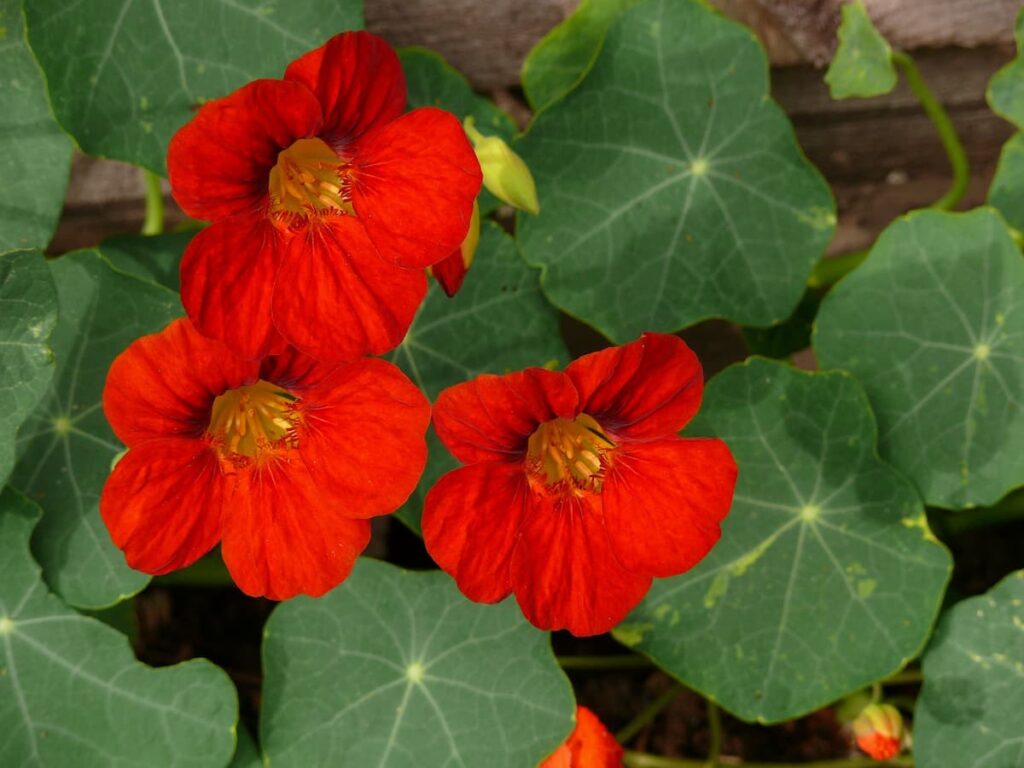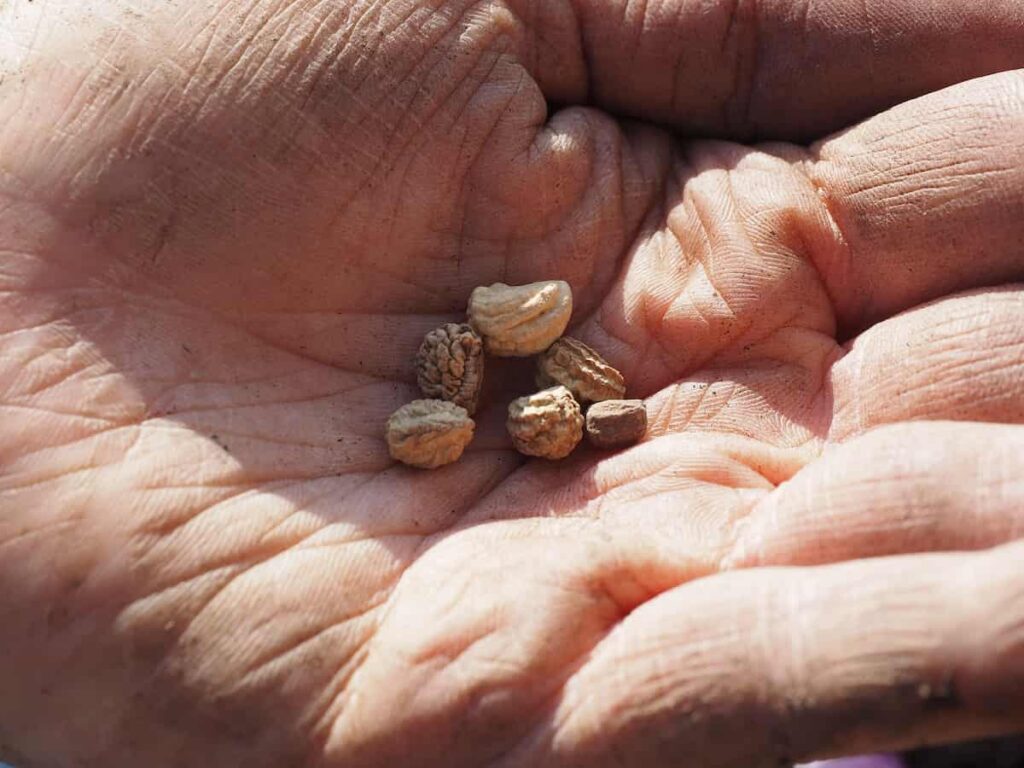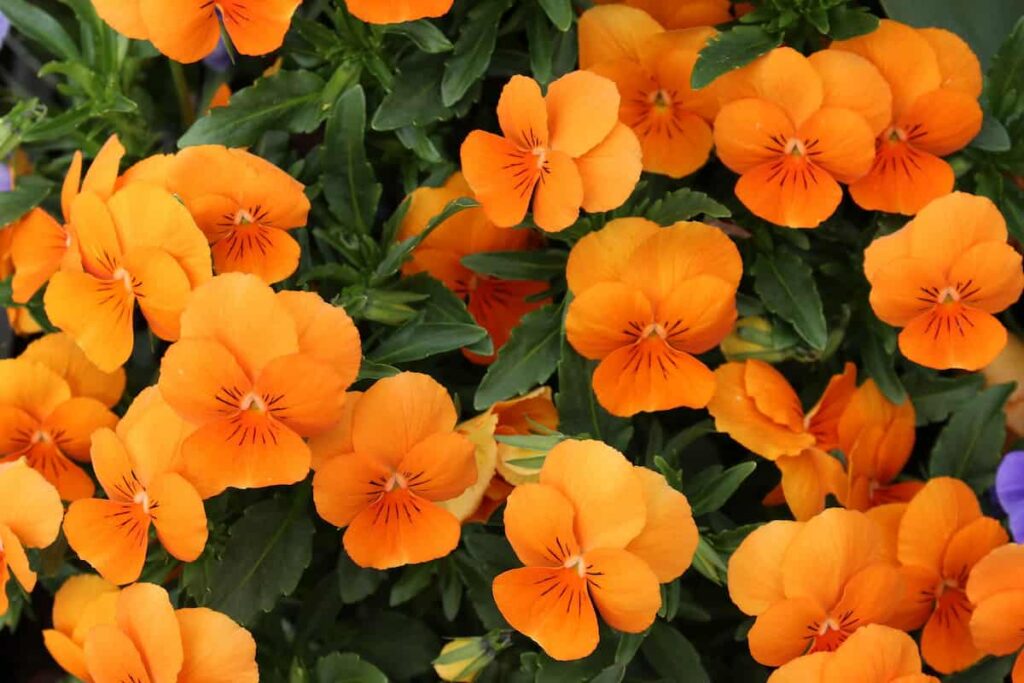Nasturtiums can be grown from seed, but they are more commonly propagated by division or stem cuttings taken in the early summer. Once established, Nasturtiums will self-seed and be cultivated in any well-drained soil type. They can grow well in various temperatures and are suitable for growing in various climates.

Nasturtium can be easily grown from seed to harvest with a few simple steps. Once the plants are established, they will need little tending other than a good watering schedule and occasional fertilization. The Nasturtium blooms are vibrant and attractive, making them easy to grow and enjoy.
How to grow Nasturtium from seed
How long does it take to grow Nasturtiums from seed?
- Assuming fresh, clean seeds and the right growing conditions, Nasturtiums will germinate in 7 to 14 days and reach maturity in around 60 days. Harvesting Nasturtiums will generally take around ten weeks, although this can vary depending on how well the plants are grown.
- Nasturtiums are a cool season crop that is easy to grow from seed. They typically take around 60 days to mature but can vary depending on the variety. Once the plants have matured, they will need to be harvested. Nasturtiums are best eaten fresh but can also be used in salads or cooked dishes.
Harvesting Nasturtium seeds
Nasturtiums are an easy, drought-tolerant annual to grow from seed. Start indoors in early spring before the ground has thawed, or direct sow outside after the first hard frost. Once established, thin to 1-2 plants per square foot and water sparingly until germination. Nasturtiums will self-seed, so be prepared to replant every few years. Harvest seedheads when they are bright green and firm, and you can store them in a dry place for up to two years.
The best month to plant Nasturtium seeds
- Nasturtiums are a great choice for gardeners wanting an easy-to-grow annual that is brightly colored in the summer. You can plant seeds in early spring, and they will germinate within a few weeks. Once the plants have grown several inches, they can be transplanted into the garden. Nasturtiums prefer full sun but will grow in partial sunlight as well. They are drought-tolerant and perform well in sandy, rocky, or alkaline soils. Harvesting Nasturtiums can be done throughout the summer, and the flowers are edible.
- If planting Nasturtium seeds indoors, start the seeds four to six weeks before your desired planting date. You can sow the seeds directly outdoors after all danger of frost has passed, or you can transplant young plants into the garden 2 to 3 months before the last frost. Nasturtiums grow best in full sun and average temperatures between 16°C to 30°C.
In case you missed it: How to Grow Parsley from Seed: A Detailed Guide to Planting to Harvest

Sun requirement for growing Nasturtium
Nasturtiums are cool-season flowers and prefer full sun or partial shade. They grow well in sandy soil with good drainage but can also be grown in heavier soils. Nasturtiums need about 8 hours of sunlight per day for optimum growth. When planting Nasturtium seeds, keep the surface moist until they germinate, then water them regularly.
Tips for preparing Nasturtium seeds before planting
Nasturtium seeds must be washed and dried before planting. Use a clean container with a small hole in the bottom, and fill the container with water. Add the Nasturtium seeds to the water and soak them for 12 to 24 hours. After soaking, drain them and place the Nasturtium seeds in a dry container. The next day, shake the seeds to remove any excess water. Bake the seeds at 94°C for 8 to 10 hours or until they are crisp. Nasturtiums can also be planted directly outdoors or indoors.
Water requirement for growing Nasturtium
- Nasturtiums can grow in various climates. They like moderate to high water levels but do not like excessively wet soils. Nasturtiums will grow best in loose, well-drained soil and fertilized monthly with a liquid fertilizer. Nasturtium is a cool-weather crop that needs frequent watering to maintain optimal growth. Water them every two to three days in the early stages of growth and then every four to six days as they grow larger.
- Nasturtium is a drought-tolerant annual plant that prefers moderate temperatures and medium to high humidity levels. They should be grown in well-drained soil and require 50 gallons of water per plant each year. Nasturtium seeds germinate in about seven days when sowings are made in early spring.
In case you missed it: How to Grow Lemongrass from Seed: A Detailed Guide for Planting to Harvesting

Tips to get more Nasturtium flowers
Nasturtiums are easy to grow from seed, but you’ll need to start them indoors several weeks before the weather is warm enough. Sow Nasturtium Seeds in a moistened soil mixture and keep them evenly moist. Nasturtium plants will grow well in partial shade or full sun, but they prefer cool weather. Once the flowers have opened, remove the stalks and enjoy the edible flowers.
The best soil for growing Nasturtiums
- The first step in preparing your soil for Nasturtium cultivation is to remove any existing plants and debris. This will help improve drainage and aeration in the soil, which are essential for healthy plant growth. Once the ground has been cleared, you must add organic matter to enrich the texture of the soil and promote growth. Nasturtiums prefer well-drained soils with a pH of 6.0-7.5. You can also add lime or sulfur to adjust the acidity level. Finally, add plenty of organic amendments before planting your Nasturtium seeds.
- Nasturtium is an easy-to-grow plant that thrives in most soil types. It prefers fertile, well-drained soils with ample moisture and partial shade. Aerate the soil before planting to help improve water retention and drainage. Nasturtiums like full sun but will tolerate some light shade.
In case you missed it: How to Create a Beautiful Flower Garden in the Balcony

Growing Nasturtiums in pots
- Nasturtiums are the best addition to any garden because they add color and texture. They grow well in pots but do best if planted in full sun. Nasturtiums need deep pots because they grow very tall. A 6-inch pot will be fine for a small Nasturtium, but a 12-inch pot is better for larger plants. Avoid using shallow containers because the roots won’t have enough soil to grow deep, and the plants will be more susceptible to root rot.
- Nasturtium plants grow best in containers at least 12 inches in diameter and six inches deep. Choose potting soil high in organic matter and containing adequate water, phosphate, and nitrogen. Sow the seeds directly into the container soil and water them regularly. Nasturtiums will reach maturity in about 60 to 70 days.
Do Nasturtiums need a trellis?
Nasturtium can be grown from seed, but they do best if grown in a trellis. Trellises will help the Nasturtium to grow tall and produce bigger flowers.
Why are my Nasturtiums so leggy?
You can grow Nasturtiums from seed, and they will reward you with large, vibrant blooms in early summer. However, if your Nasturtiums are leggy, there may be a reason. Leggy plants are likely struggling with poor soil drainage or inadequate sunlight. You can help remedy this by improving the soil conditions or providing light for the plants.
The best fertilizer for growing Nasturtium
Nasturtiums add color and flavor to your garden. Fertilize your Nasturtiums every three weeks during the growing season with a diluted houseplant fertilizer. Once they reach maturity, you can stop fertilizing them and enjoy their vibrant flowers all summer.
In case you missed it: Top 10 Stress-relieving Plants to Grow in Your Garden: Best List

Germinating Nasturtium seeds indoors
Nasturtium seeds can be germinated indoors in a propagator or soil. You can start the seeds four to six weeks before your desired planting date. When planting Nasturtium seeds, cover them with soil and water them well. Germination usually takes around 7 to 14 days. Once the seedlings emerge, they should be hardened off by keeping the temperature at around 15°C for a couple of weeks. Once the plants are hardy off, they can be moved into their garden space. Nasturtiums do best to grow in loose, well-drained soil that is pH 5.5 to 6.0.
Best time to harvest Nasturtium flowers
This depends on the climate your area experiences and the phase of growth of the plants. In most cases, harvesting Nasturtium when it is in its peak bloom will produce the highest quality flowers. Nasturtium typically blooms from May to July in temperate climates but can flower anytime in warmer climates. To ensure a bountiful harvest, start harvesting Nasturtium as soon as they bloom and continue until all blooms have been picked.
Planting Nasturtium seeds
First, choose a sunny location where the soil is moist and fertile. Secondly, sow the seeds 1 to 2 inches deep and water them regularly. Once the seedlings have rooted themselves, thin them out so that there are about 8 to 10 plants per pot. Finally, fertilize the plants once they reach 6 to 8 inches tall with a balanced fertilizer or emulsion mixture every two weeks during the summer months.
In case you missed it: 10 Best Fragrant Plants for Indoors: Top List

Pruning for Nasturtiums
- To produce the best Nasturtium plants, you’ll need to pay close attention to their pruning. Pruning should be done in early spring when the plants are just starting to grow. Start by trimming off any long, spindly branches and dead wood. Then, remove any flowers that have developed and any smaller side branches that may be growing in between the flowers. Finally, cut off the main stem 2 to 3 inches below the soil surface.
- Deadheading means removing flowers from plants to maintain a healthy crop. Deadheading Nasturtium plants will help to prevent flowering and promote the prolific production of seed pods. Prune off the oldest flower heads on Nasturtium plants, as they will become senescent and may not produce viable seeds. Be careful not to kill the younger leaves on the plant; cutting them too close to the main stem can cause them to die. Finally, ensure to keep all flowers from a single cluster. Doing so can lead to lopsided growth and reduced yield.
Harvesting Nasturtium flowers
Nasturtiums add beauty to any garden and can be grown from seed. Start by planting the Nasturtium seeds in early spring, before the soil has dried. Make sure to give the seeds plenty of water, then monitor their growth regularly. When the flowers have formed, you can start harvesting Nasturtiums by cutting at the base of the stem.
Conclusion
You can easily grow Nasturtium from seed, and they produce colorful flowers that can be used as a flower bouquet. Select a suitable variety for your climate and soil type to grow Nasturtium from seed. Seeds should be planted at the beginning of spring and need water and fertilizer regularly throughout their growth cycle. When the plants have grown tall enough, they can be harvested by picking the flowers or cutting the stem near the ground. Enjoy the bright colors and sweet flavor of Nasturtium flowers.
- Where to Place Indoor Plants in Your Home
- How to Grow Tomatoes Organically at Home: A Comprehensive Guide
- Organic Gardening on a Budget: Low-Cost Methods and Materials
- Gongura Seed Germination and Planting Methods
- Cabbage Seed Germination and Selection
- Broccoli Seed Germination and Selection
- Asparagus Seed Germination and Variety Selection
- Seasonal Flower Gardening: Best Practices for Spring, Summer, Fall, and Winter
- How to Grow Hibiscus from Flower
- Plantation Ideas for Home Decoration: A Beginners Guide
- Flower Garden Designs and Layouts for Beginners
- Planting and Spacing Techniques in Papaya: A Beginner’s Guide
- Growing Gold: Essential Techniques for Planting Pineapples
- How to Make Kalanchoe Plant Bushy: Home Remedies and Solutions
- 11 Reasons Why Your Gardenia is Not Blooming: Home Remedies and Solutions
- Eco Elegance: The Guide to Designing a Drought-Tolerant Landscape
- Gardening on a Slope: Strategies for Hillside Landscaping
- Nourish and Flourish: Top Organic Mulches for Thriving House Plants
- Everything You Want to Know about Indian Mogra Flower: Discover Uses and Growing
- Green Thumb Success: Expert Tips for Cultivating Greenhouse Pumpkins All Year Round
- Maximize Growth & Flavor: The Ultimate Guide to Companion Planting in Herb Gardens
- How to Control Rhododendron Problems Naturally: Home Remedies and Organic Ways to Fix Them
- Natural Magic: The Remarkable Benefits of Cinnamon for Plants
- Best Steps to Revive Dying Tulip with Natural and Organic Treatment
- 10 Reasons Why Your Angel Trumpet is Not Blooming: Remedies and Treatment
- How to Fix Periwinkle Leaf and Flower-Related Problems: Natural Remedies and Solutions
- How to Fix Zinnias Leaf and Flower Problems: Discover Natural and Home Remedies
- Organic Steps to Induce Lemon Tree Flowers: A Comprehensive Guide
- Bloom Booster: Crafting the Perfect Homemade Bougainvillea Fertilizer
- Optimizing Growth: A Guide to Applying NPK Fertilizer for Potted Plants
- 10 Best Homemade Fertilizers for Rubber Plant: DIY Recipes and Application Method
- How to Boost Female Pumpkin Flowers: Effective Steps for More Flowers and High Yields
- Transform Your Indoor Garden: Top Benefits of Pink Salt for Houseplants
- 10 Best Homemade Fertilizers for Peacock Plants (Calathea): Easy DIY Guide
- Unlock Blooms: 9 Reasons Why Your Potted Chrysanthemum is Not Blooming
- 8 Reasons Why Your Potted Hibiscus is Not Blooming: Fix it with Simple Solutions